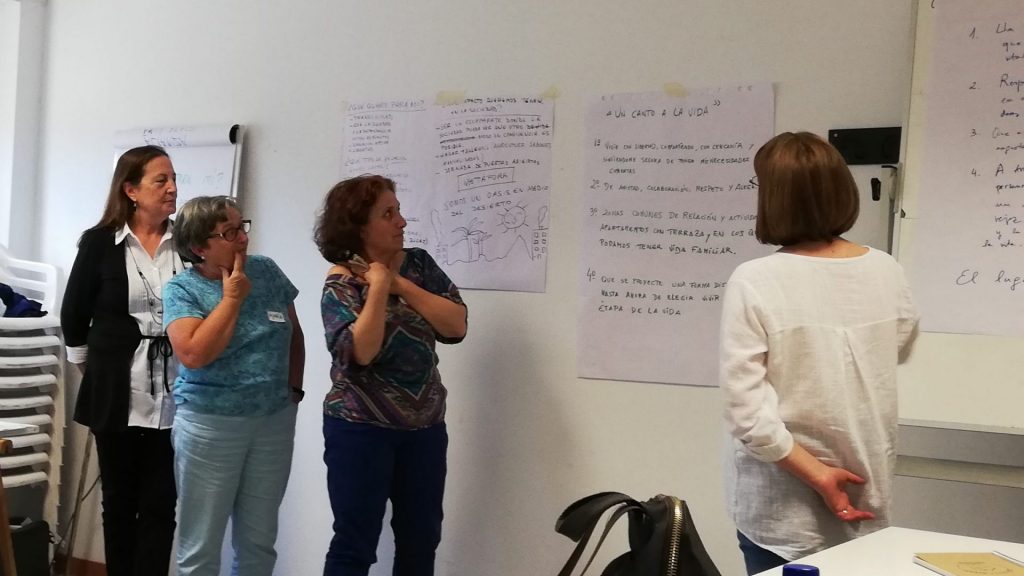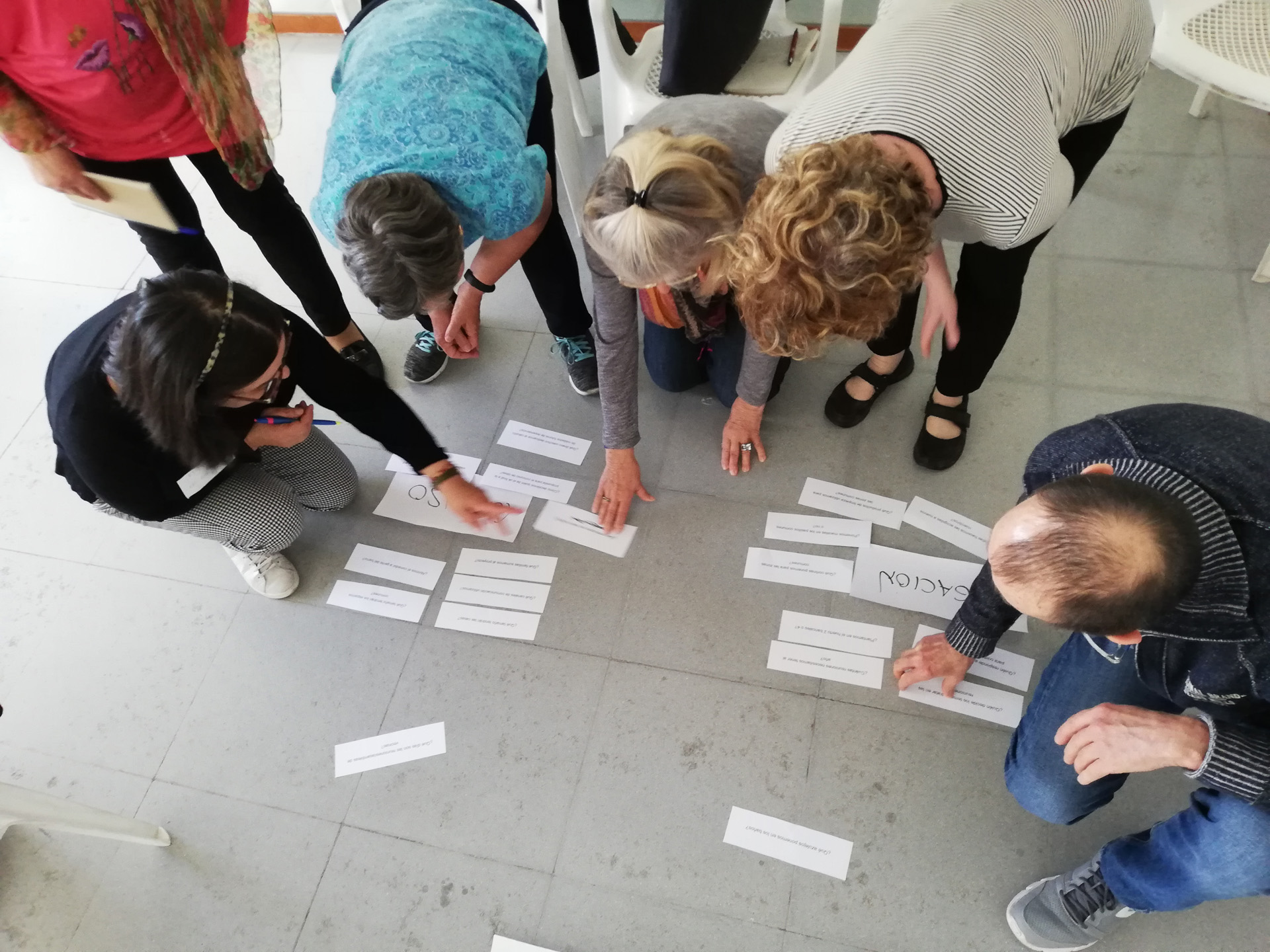
Cohousing senior Cosmos de Rivas
NUESTRO GRUPO
Estamos respondiendo a nuestras necesidades y deseos con un proyecto con valores y visión colaborativos.
Las personas que formamos la Asociación Cosmos de Rivas planteamos la participación y la vida activa a partir de nuestras capacidades personales y experiencias, enriquecidas por nuestras capacidades colectivas y las ayudas externas necesarias. Queremos ser referencia actual y futura en la ciudad de Rivas Vaciamadrid, por lo que divulgaremos nuestra experiencia.
Estamos diseñando nuestro proyecto conectando los espacios privados con los comunes y comunitarios, dando prioridad al desarrollo de relaciones amigables, de solidaridad y de colaboración social.
Cohousing Cosmos de Rivas es Cohousing Rivas Vaciamadrid y Cohousing Madrid así como Cohousing en Rivas Vaciamadrid y Cohousing en Madrid, Cohousing senior y Cohousing mayores
NUESTRO PROYECTO
Trabajamos en las múltiples facetas del cohousing, definiendo así nuestra propia forma de vida. Estamos avanzando en todos los aspectos que determinarán la vida en común, ya que todos están relacionados, entendiendo no obstante que cada uno de ellos requiere de un ritmo de desarrollo adecuado a cada fase del Proyecto.

Somos personas que voluntariamente nos organizamos para realizar un proyecto en común, creando vínculos significativos entre nosotras e implicándonos activamente en el entorno donde vivimos.
Hemos determinado que la comunidad residencial sea asequible e inclusiva y que atienda a los parámetros de sostenibilidad ambiental.

Tenemos una solución común solidaria para el envejecimiento y la atención a la dependencia.
Son principios de nuestro Proyecto la solidaridad y los cuidados mutuos, favoreciendo la autonomía personal en todo momento.
Así, damos una solución a la soledad no deseada y a la falta de motivación para realizar actividades. Fomentamos la calidad de vida, un envejecimiento saludable, el autogobierno, un desarrollo personal y una vejez activa.

ATENCIÓN CENTRADA EN LA PERSONA
La ACP busca cuidar y apoyar a las personas para que puedan seguir familiarizadas con su entorno y en su vida cotidiana. Hacerla efectiva implica el reconocimiento de su valor y singularidad.
Adoptamos este modelo porque nos parece que es la forma que mejor consigue que la persona continúe, en esta etapa de la vida, teniendo una vida propia integral y digna.

Tenemos previsto un programa de usos y superficies con la definición básica de espacios privados, espacios comunes y espacios de servicio, así como una evaluación previa de costes totales de promoción.
Asimismo, estamos definiendo el modelo de atención a la dependencia óptimo para nuestra comunidad, sabiendo que es un factor importante a nivel económico.

Nuestro proyecto tiene en cuenta las tres dimensiones de la sostenibilidad (social , económica y medioambiental), buscando un equilibrio entre ellas adaptado a las posibilidades y objetivos del grupo para conseguir así una sostenibilidad fuerte: Vivible, Equitativa y Factible.
Durante el proceso del Proyecto estudiaremos junto a nuestro Equipo Técnico todas las opciones posibles hasta llegar al modelo óptimo para nuestra Comunidad.

El Proyecto de Arquitectura se desarrollará mediante metodología formativa y participativa, de forma horizontal y en colaboración estrecha con nuestro Equipo Técnico.
El edificio será la construcción de nuestra propia forma de vida, plenamente adaptado y adaptable a todas las etapas de vida y con el equilibrio justo entre convivencia e intimidad.
PROYECTO SOCIAL
Nos implicamos activamente en el proyecto social de Rivas-Vaciamadrid.
Próximos eventos
Un cohousing hecho por nosotros mismos con un proceso participativo
Cohousing Cosmos de Rivas es Cohousing Rivas Vaciamadrid y Cohousing Madrid así como Cohousing en Rivas Vaciamadrid y Cohousing en Madrid, Cohousing senior y Cohousing mayores

Ven a conocernos a nuestro próximo encuentro de información con interesados.
ACTUALIDAD
La experiencia en participación, autogestión y apoyo mutuo, necesaria para ser parte de la comunidad de un cohousing, se adquiere durante el desarrollo del Proyecto. Aquí os mantenemos al día del Progreso del Proyecto, los eventos en los que participamos y las noticias importantes del cohousing.
Haciendo Grupo
En nuestro deseo de cohesionar el grupo, seguimos organizando jornadas en la naturaleza que tanto nos gustan sin olvidar la cultura del entorno en el que nos movemos. Fin de…
Conociendo el entorno: Visita a la Laguna del Campillo
El pasado octubre realizamos una salida para conocer la Laguna del Campillo, con el fin de conocer nuestro entorno y, al mismo tiempo, seguir creando comunidad. La excursión finalizó con…
Comenzamos en el Centro de Recursos Ambientales Chico Mendes
Continuamos con la Preciosa Ruta del Espartal Y terminamos con una estupenda comida. Un estupendo día en unión





